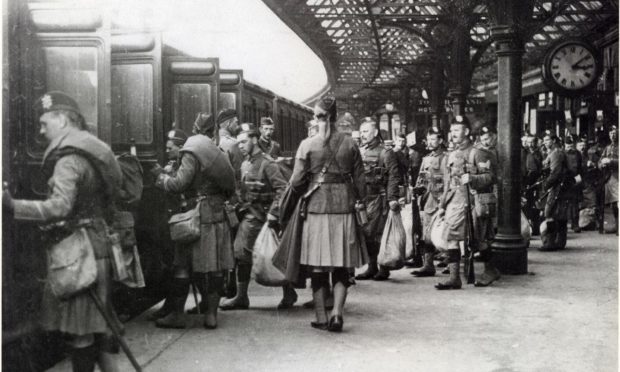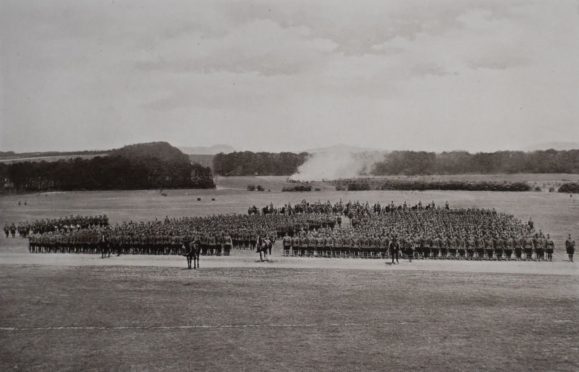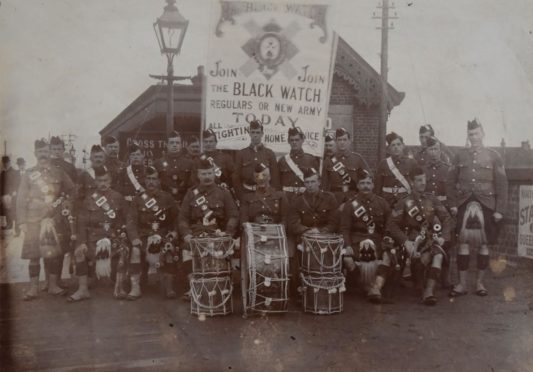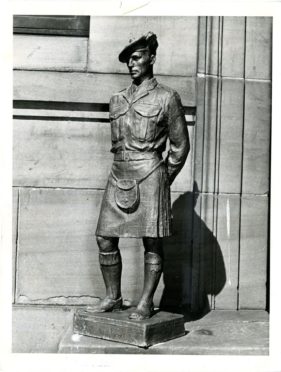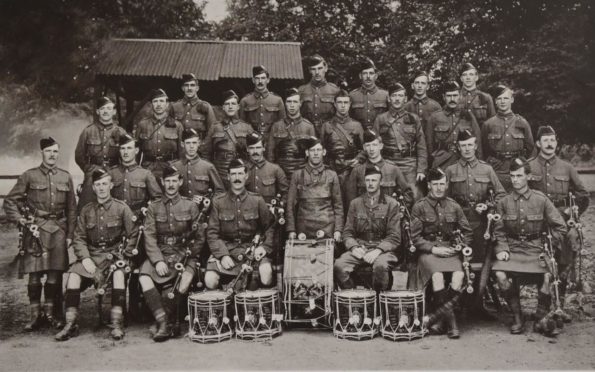Tens of thousands of Black Watch soldiers would test their own capacity for courage during the First World War.
The Black Watch raised 25 battalions that served in Europe, the Middle East and Asia as part of the British forces fight against Germany.
Over 8,000 of its men were killed.
Unsung heroes
There is no shortage of memoirs telling its rich history but a new book shines a light on the lesser-known stories of the unsung heroes who went beyond the call of duty.
The Black Watch & The Great War was written by members of the regimental family – those who have worn the Red Hackle, descendants of The Black Watch soldiers of 1914-18, and close associates of the regiment.
Some of the stories include the Black Watch men who hailed from Latin America and the ministers of the Kirk who set aside their non-combatant status and took up arms.
Highlights also include the enterprising escape from German captivity of men of the 7th (Fife) Battalion which had taken over the front line at Louverval on March 1 1918.
At the time there had been rumours of an imminent German offensive reinforced by increased activity behind enemy lines.
The Battalion anticipated action and, according to its official historian, “all ranks were now eager for a fight and it was in that spirit that the 7th met the German offensive”.
The intense bombardment, comprising high-explosive and gas shells, all but destroyed the front line trenches and only a few survivors of C and D companies were able to withdraw to battalion headquarters.
The Black Watch “resisted gallantly” but outflanked and under increasing pressure, the survivors were compelled to withdraw to the Beaumetz-Morchies road, which was held by A company, approximately 60 strong, and by the remainder of the battalion – some 30 men.
Heavy losses
In the coming days the battalion with what remained of the rest of the 51st (Highland) Division would fight a series of actions as the German army continued to advance.
The losses sustained during the German offensive were estimated to be in the region of 23 officers and 627 other ranks out of a strength of some 39 officers and 941 men.
Lance Corporal Andrew Harrower from Cowdenbeath, Corporal David Mills from Kirkcaldy and Private William Moyes from Tayport were listed as missing.
Harrower, Mills and Moyes had been captured by the Germans and were taken to Villers-lès-Cagnicourt with some 600 British prisoners of war.
On the evening of April 18, accompanied by Corporal Charles Mottershead, 9th Royal Welsh Fusiliers, the four men made their escape, reaching their own lines the following morning.
Exchanging their kilts for discarded French civilian clothes they “ran and walked and crawled” a distance of some 20 miles, guided by the sound of the guns.
Harrower, Mills and Moyes each received the Military Medal.
High Wood
Another story of incredible bravery in the book highlights the men of the 6th (Perthshire) and 7th (Fife) Territorial Battalions, who were preparing for an assault on High Wood, the heavily fortified German position that dominated the Bazentin Ridge, crowning a large upland almost 100 feet high, in July 1916 .
Since the beginning of the Battle of the Somme, there had been several unsuccessful attempts to capture High Wood.
The Black Watch were now tasked with taking its western and eastern corners.
However, the artillery barrage had proved insufficient to destroy the German trenches.
The leading companies of 6th Black Watch were subjected to heavy machine-gun fire almost immediately.
Despite mounting losses, the battalion managed to reach the German barbed wire some 25 or 30 yards from the enemy frontline trench.
Captain Edgar Leslie Boase, a well-known figure in Fife and Dundee, gave his life at High Wood in an effort to save his men.
Boase was an experienced Territorial Army officer having served in France with the 4th Black Watch in early 1915.
A prospective Unionist candidate for Dundee, his death was described as “an extremely gallant one, occurring during a more than plucky effort to prevent the instant death of the men under his command, and involving almost certain death to himself, of which he was fully aware”.
Captain James Gillespie, C Company, an architect from St Andrews, was killed immediately having crossed the parapet of the British trench.
Shot by a sniper
Boase took his place and led Gillespie’s company toward the German positions in High Wood.
He volunteered to go forward and extinguish a fire that had broken out beside a stock of abandoned German ammunition which, had it exploded, would have inflicted heavy casualties on his men.
He handed over his revolver, took an empty Lewis gun-bag and ran out into fierce enemy machine gun and rifle fire.
He was warned that he would be hit, but still went on to put out the fire.
Boase was shot by a sniper having accomplished his objective, one of nine officers of the 7th Black Watch killed on July 30 1916.
A very popular figure, his death was the cause of much regret in Dundee.
His mother later donated 1,000 guineas to Dundee Royal Infirmary to endow a bed in his memory, initially to be used in a ward treating wounded soldiers.
The Black Watch was awarded 69 battle honours during the First World War and four Black Watch men received the Victoria Cross.
Dr Derek J Patrick
The book has been edited by Dr Fraser Brown and Dr Derek J Patrick, with a foreword by Lieutenant-General Sir Alistair Irwin, former Adjutant-General to the Forces in the UK.
Dr Patrick said: “I’d always been aware that my great-grandfather was killed in action on the Somme in September 1916 while serving with the regiment.
“I was always conscious of this but it was a trip to the battlefields when I was at high school that really made the difference.
“I had the opportunity to visit his grave in Caterpillar Valley Cemetery and from that point was really interested in finding out more about his experiences.
“My parents always encouraged this and with an aunt and an uncle who were both teachers it just escalated.
“My PhD was on the Scottish Parliament 1689-1702 but when I was teaching at Dundee my interests moved in a different direction.
“Dr Billy Kenefick and I taught a popular honours course on the ‘Scottish Soldier’ and were the co-founders of the Great War Dundee Commemorative Project.
“It was through Billy that I met Fraser who was completing an MLitt at Dundee.
“I’ve been fortunate to meet many other Black Watch veterans like George Seath, Bob Scott, Ronnie Proctor, Tam McCluskey and Brian Smith, and was extremely proud to be made an associate member of the Regimental Association.
“The book really came from a series of conversations with Fraser.
“We knew there was real enthusiasm for a book on the regiment’s role in the Great War.
“We already have Wauchope’s excellent ‘History’ published in 1926 and felt this was an opportunity to tell some of the lesser-known stories.
“The book has been described as a history of the regiment by the regiment and that’s what it is.
“I can’t think of another publication that involves those with a direct connection to the regiment in this way.
“For me it’s full of highlights.
“It’s a book full of characters and includes many stories of courage and sacrifice, and many that haven’t been covered before.
“This and its contributors are the real strength.”
Dr Fraser Brown
Dr Brown joined The Black Watch in 1962 as a junior soldier and served for six years.
He graduated from Stirling in 1975 and taught in secondary and special education in Stirling where he was both Head Teacher and Education Officer.
On retiral, he and Major Ronnie Proctor from Kirriemuir developed and delivered the outreach programme ‘Your School, The Black Watch and the Great War’ in schools in the regimental area on behalf of old The Black Watch Museum.
He said: “First, from the outset we drew heavily on Black Watch oral tradition when we identified possible content for the book and prioritised research in terms of what the regimental family saw as important, so the regimental family set the agenda here.
“As a result, previously under-researched and less well-known regimental stories appear – all subjected to rigorous research standards – produced by authors who have themselves become historians in the process.
“Second, a set of possible future avenues for research have been recorded for use by future historians.
“Finally, a very small addition to the legacy of The Black Watch [Royal Highland Regiment] has been made.”
